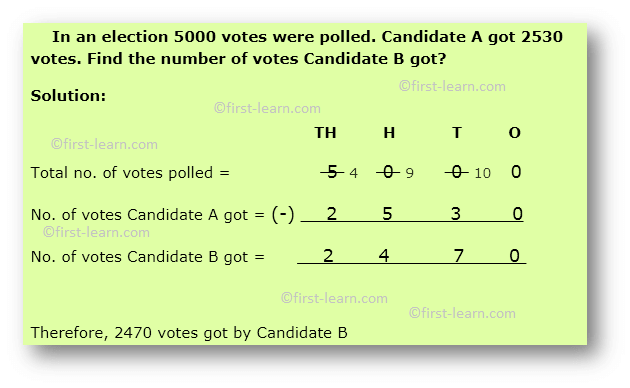Word Problems on Addition and Subtraction of Whole Numbers
In the previous subtopics we have learnt how to perform addition and subtraction of whole numbers. Now we are moving a step ahead and would learn how to solve word problems on addition and subtraction. It is nothing but along with addition/ subtraction we have to write statements. Moreover, these word problems on addition and subtraction are also called story sums. That means there would be a story and by reading that story we will have to determine what operation is needed addition/ subtraction along with the statements.
1. What should be added to 5286 to get 9632?
Solution:
The question says what should be added to 5286 to get 9632. That means 5286 is the smaller number than 9632 and moreover the difference between those two numbers should be added to 5286 to get 9632. That means we have to subtract the two numbers
TH H T O
9 6 5 3 12 2 12
(-) 5 2 8 6
4 3 4 6
The subtraction involves borrowing. 6 cannot be subtracted from 2 hence 1 is borrowed to make it 12. Again 3 in the tens place is reduced to 2 and 8 cannot be subtracted from 2. Therefore in the tens place 1 is borrowed from 6 in the hundreds place and 6 became 5. In the tens place after borrowing now it is 12 and hence 8 can be subtracted from 12. In the thousands place 5 is subtracted from 9
Therefore, 4346 should be added to 5286 to get 9632
2. What should be subtracted from 854 to get 235?
Solution:
The question says that something has to be subtracted from 854 to get 235. Therefore, 854 is the bigger number and 235 is the smaller number. Again here we have to find the difference between the two numbers. Hence, 235 need to be subtracted from 854.
H T O
8 5 4 4 14
(-) 2 3 5
6 1 9
This subtraction involves borrowing as in the ones place 5 cannot be subtracted from 4 and therefore we have to borrow 1 from 5 to make the number at the ones place as 14. Now, 5 can be subtracted from 14 in the ones place. In the tens place 5 became 4 however, there is no need of borrowing as 3 can be subtracted from 4. Again in the hundreds place as well there is no need of borrowing as 2 can be subtracted from 8.
Therefore, 619 should be subtracted from 854 to make it 235
3. There are 764 boys in a school and 513 girls in the school. Find the total no. of children in a school.
Solution:
TH H T O
No. of boys in the school = 7 6 4
No. of girls in the school= (+) 5 1 3
Total no. of children 1 2 7 7
Therefore, 1277 children are there in the school
In the ones column 4 and 3 is 7. Then in the tens column 6 and 1 is 7 and in the hundreds column 7 and 5 is 12. There is no carry over in this addition.
4. In an election 5000 votes were polled. Candidate A got 2530 votes. Find the number of votes Candidate B got?
Solution:
TH H T O
Total no. of votes polled = 5 4 0 9 0 10 0
No. of votes Candidate A got = (-) 2 5 3 0
No. of votes Candidate B got = 2 4 7 0
Therefore, 2470 votes got by Candidate B
In the tens column there is a need for borrowing as 3 cannot be subtracted from 0. One is borrowed from the zero in the hundreds column. But there is 0 in the hundreds column and 0 means nothing how can it lend? Therefore the 0 in the hundreds column borrows 1 from the thousands column. Now, after all borrowing there is 10 in the tens column, 9 in the hundreds column and 4 in the thousands column. Then the subtraction is performed.
From Word Problems on Addition and Subtraction of Whole Numbers to HOME PAGE
Recent Articles
-
What Is Plasma? | Blood Plasma | Proteins | Nutrients | Cholesterol
Nov 07, 25 10:29 AM
Blood is a mobile fluid which is a connective tissue and is derived from the mesoderm like cell any other connective tissue. Colour of blood is reddish and that flows inside the blood vessels by means… -
Disorders of Respiratory System | Tuberculosis | Pleurisy | Emphysema
Oct 28, 25 11:39 PM
Tuberculosis is very common disease and is caused by a type of bacteria called Mycobacterium tuberculosis. This disease causes different trouble in the respiration and infection of several parts of th… -
Regulation of Respiration | Respiratory Centres | Inspiratory Area |
Oct 14, 25 12:13 AM
Respiratory Centre is the area that controls the rate of respiration and it is observed to be located in medulla oblongata and pons. Respiratory Centre has the following will dispersed components like… -
Explain Transport of Gases | External Respiration | Tissue Respiration
Oct 09, 25 11:35 PM
In humans gaseous exchange is completed in the following ways the steps are - External Respiration or Breathing - Breathing in false taking in of Oxygen and giving out of carbon dioxide in the body. M… -
Kind and Number of Teeth | Location of Teeth in Mouth | Care of Teeth
Sep 11, 25 12:52 AM
Kind and Number of Teeth






New! Comments
Have your say about what you just read! Leave me a comment in the box below.